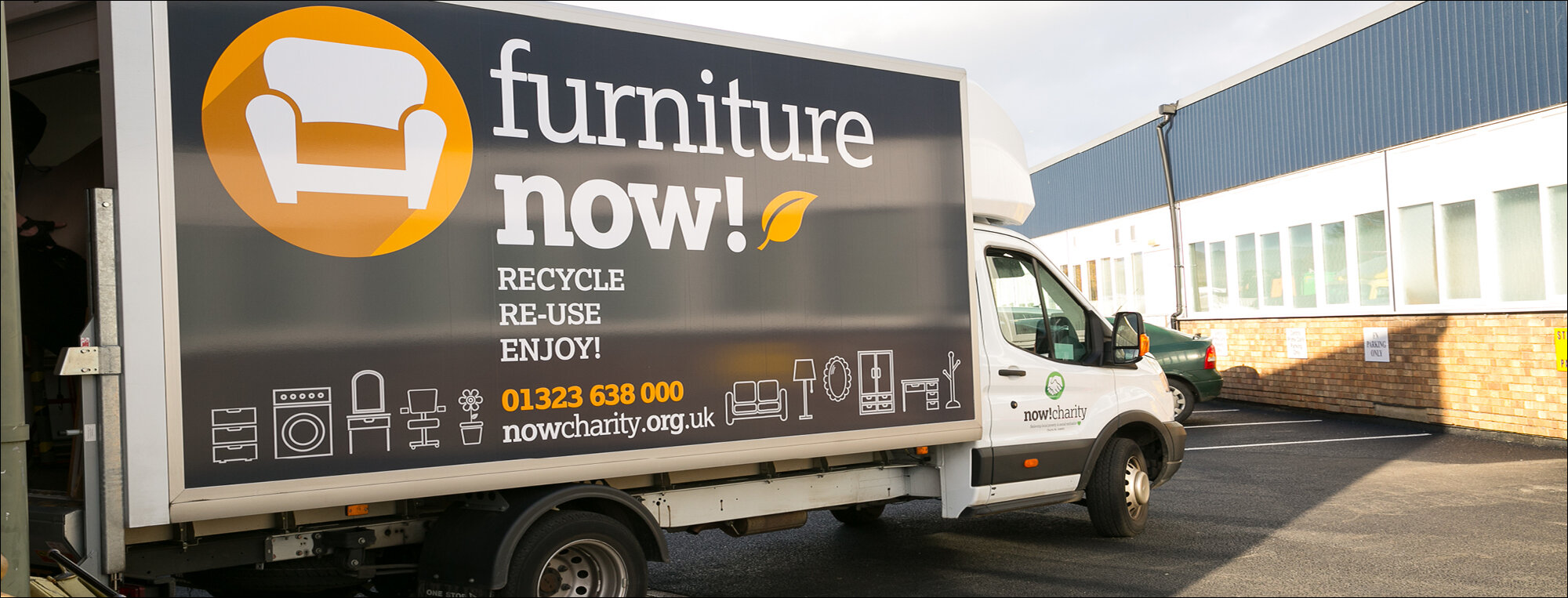How Furniture Now! benefits both people and planet
Did you know? 10 million household items are sent to landfill every year. At least 3 million of these items could be immediately reused by members of the public.
The reuse of furniture, electricals and other household items can make a great difference. Not only does it help reduce the amount of waste going to landfill, it can also make a difference to people’s lives, because many of the reused items are used by people in need.
There are a few potentially confusing terms out there – so we thought we’d explain reuse vs recycling and circular vs social economies…
Are the terms reuse and recycling different?
Yes, in fact they can even be identified by different associated logos!
Recycling adopts the concept of reducing a whole item into individual raw materials (plastic and metals) which can be collated and used again, often for a completely different purpose.
Reuse refers to using an object as it is without alteration.
The Waste Electrical and Electronic Equipment (WEEE) Regulations came into force in January 2007. They aim to reduce the amount of this waste going to landfill and improve recovery and recycling rates.
The WEEE Symbol, which consists of a picture of a crossed out bin, means that electrical items should not be disposed of in your regular waste bin and should be recycled.
Reuse is typically portrayed in logos as a circular shape made up of arrows.
Furniture Now! collects hundreds of electrical items each year. Before an item can be redistributed it must first pass a PAT (portable appliance test) to ensure it is safe for future use. Items we collect which fail the PAT test are recycled, while items which pass are reused and provided to members of the public.
For each washing machine redirected from landfill to reuse, we save 29kg of CO2 emissions, whilst also providing considerable family household savings compared to them buying items new.
What is the circular economy?
The circular economy is a model of production and consumption, which involves sharing, leasing, reusing, repairing, refurbishing and recycling existing materials and products as long as possible.
In this way, the life cycle of products is extended. In practice, it implies reducing waste to a minimum.
When a product reaches the end of its life, its materials are kept within the economy wherever possible. These can be productively used again and again, thereby creating further value.
What is the social economy?
The social economy consists of a group of principles which work to bring benefit to people and planet, whilst observing a sustainable financial operating model.
It embraces a fully systemic view which merges the environmental values found within the circular economy, with the purpose-driven vision championed by social enterprise organisations.
The Furniture Now! model is a prime example of a project which delivers social economy benefits. These include:
Environmental – Furniture Now! saves hundreds of tonnes of household items from landfill each year. In 2019 our services ensured 135,306 KG of CO2 emissions were saved, reducing the Sussex county’s carbon footprint.
Social – Furniture Now! ensures items saved from households are distributed to people of low-socioeconomic status. Addressing key social challenges such as furniture poverty and child deprivation. In addition, Furniture Now! contributes positively to local employment opportunities, including holding accreditation for the UK Governments Disability Confident scheme.
For 25 years, Furniture Now! has achieved environmental and social benefits within a self-sustaining economic delivery model, powered by income from goods and services.
How are organisations balancing social impact and financial sustainability?
Many organisations value being community-driven entities - be they charities, social enterprises, CIC’s or B Corps.
There is a common misconception that groups working in this sphere view purpose and profit at opposite ends of the psychological spectrum. People may consider whether a strategical paradox exists, social-driven decisions are made with the heart and financial decisions are made with the head, right? Wrong. There is a harmony which can be achieved.
For any successful organisation to thrive it must place purpose and social impact at its core. As Simon Sinek once said, when delivering his famous Golden Circle speech, “people do not buy what you do, they buy why you do it.”
This is as prevalent now as its ever been. It is particularly evidenced in millennial’s who are showcasing a clear trend of ‘purpose purchasing’. Turning away from unethical brands and companies with a large carbon footprint. They are prepared to pay more on the basis of ethics.
Remember, there is a distinct difference between an organisation which is ‘profit-driven’ and one which is ‘financially responsible’.
For organisations who embrace the social economic model, we fully understand the benefits of employment both on families and the local economy. However, an organisation’s first priority must be to survive.
All adopted business models shall require tough decisions at some time. If an organisation does not operate with financial accountability, the knock-on effect of losing the existence of your group, staff unemployment and a loss of core community services, will likely have a far greater negative social impact.
It is a tremendous challenge for social-driven organisations to be 100% people-driven or 100% financially driven all of the time. Too much of the former runs the risk of economically destructive models, whilst too much of the latter makes it extremely difficult for your social values to shine through.
So how to organisations balance social and financial sustainability? Be ethically minded, ensure your audience understands your ‘why’ and embrace financially responsibility rather than being ‘profit-driven’.



